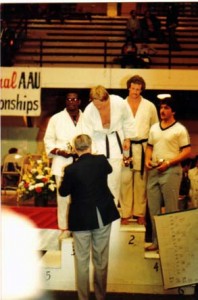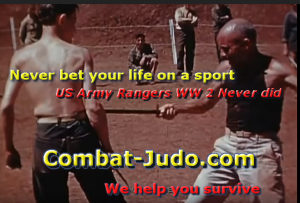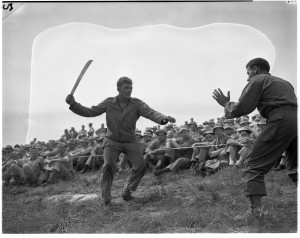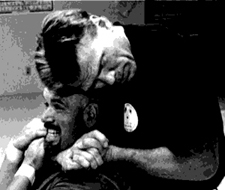5 Reasons Combat-Judo is Your Go To Fighting Art for Self Defense, Self Protection & Conflict Resolution
One of the crucial aspects of Combat-Judo is that while it owes its inception to Jigoro Kano it has not remained the same as when he originated it. Combat-Judo as we know it now has gone through several evolutions or generational advances. To take a brief look at these generations it is best to follow a chronological order. The first generation is Kano’s work: he distilled judo from the various jiujitsu schools in Japan–retaining and using those techniques that were both effective and fairly safe to train, practice and drill. He developed several renditions of judo: sport, self-defense and combat. As far as Combat-Judo is concerned the second generation began in WW 2. The Marine Raiders, the Army Rangers and Army Alamo Scouts (the most effective Special Forces the USA has produced) used Combat-Judo. Their work with the Filipino Guerrillas led to further development as the Filipinos incorporated Combat-Judo with stick, blade and some different striking aspects (than the original Kano work), which added more depth and breadth allowing Combat-Judo to be used in more warfare theaters. The third generation owes its birth to John Saylor–specifically when he started modifying the Sport Judo to be more street effective. He removed risky moves or those techniques that were exploitative of a sport setting (sacrifice throws that leave the person vulnerable in a mortal combat situation). This is a crucial element in modern Combat-Judo and it will serve the reader to know more details.
John was a high level sport judo competitor (Pan American Champion, just to name one award in judo) and he felt the need to take the underlying design of judo–use high percentage attacks or defenses and drill them with isomorphic drills–and apply it to the street. His expression of this can be found in his Shn Gi Tai approach. While many view his grappling (Shin Gi Tai) as largely sport oriented (largely due to his work with athletes in sport fighting and his seminars which were 99% focused on sport fighters) there was an underlying combat application dying to get out. Which takes us to the fourth generation, namely, Christophe Clugston’s approach of redefining the original Combat-Judo away from the sport of judo and infusing modern science and analysis to aide in development. That is to say his background and his work via Combat JKD, Comhrac Bas, and his high level sport fighting level in Boxing, Muay Thai and K1 allowed him to weed out what would be essential for combat and what would not be. In this regard, he was the perfect synergistic force to propel Combat-Judo into the 21st Century.
In many regards John and Christophe both came to the design of Combat-Judo not as a static art but one that was and is dynamic. Far from being frozen in one time period, Combat-Judo changes, morphs, and evolves when new information is available. and there was a great deal of information to add: sport Judo is a serious endeavor for many countries and in their pursuit of Olympic Gold medals there have been several academic studies done on the physics, the efficacy rates of techniques and training protocols. It would be infantile not to use such cutting edge information in improving Combat-Judo. As realists both John and Christophe were adamant about keeping the science current–no out dated ninja tactics, for example. It bears mentioning that this benefit of science is an advancement that was not available during the first two generations of Combat-Judo. Its inclusion has rapidly taken Combat-Judo on a geometric progression. Specifically, scientific analysis removes time wasting trial and error. It exponentially allows for innovation using a massive data set that is nearly impossible for one or two people to create. And it reinforces the objectives to use high percentage of success moves that carry the lowest risk.
5G is Here
So where are we?
Well we are entering the 5th Generation of Combat-Judo.
That is arriving at the 5th Generation of Combat-Judo is an effect of the catalyst of the previous 4 generations. They do not exist as separate chapters in isolation, but, rather, they are chapters that synergistically work together to build a continuing saga. Or a better analogy would be to look at Combat-Judo as if it were a skyscraper–the foundation must be strong and wide enough to sustain further development. We believe that Kano’s original premise and work was sound. His formulation of judo led to three distinct branches; however, after WW2 all that remained, in public view, was the sport version. In fact few people even know about anything other than the sport version. Although John Saylor was involved with sport judo at the highest level, the Olympics–he knew the limitations of a sport version. He studied various forms of combat while trying to retain the core elements of judo as much as possible in the hopes of maximizing a self defense system predicated on judo. His endeavor was greatly aided by Christophe Clugston who had been stripping non functional combat aspects from sport fighting disciplines and redefining combat arts such as Combat JKD. It was a template that sat well with John’s mindset. The idea was to re-introduce the Combat-Judo that had found favor with the U.S. Marine Raiders, U.S. Army Rangers, and the elite U.S. Army Alamo Scouts in WW2 and with the Filipino guerrillas fighting man to man in jungle warfare. To re-introduce it solely as a historical fighting art would have been one thing–glorious as it would’ve been for certain people; however, it would’ve been selling the discipline short.
In fact using the following analogy might be quite instructive to the reader. The Model T Ford (car) has its aficionados to this day, but its real strength doesn’t lie in its black color or spoked wheels; it lies in its conceptual design. This conceptual design has allowed for improvements in the original car and it has led to to such technologically advanced cars as the McClaren and the Bugatti (to name two super cars I’d like to have)–all thousands of times better than the original Model T but still beholding to the original concept. That is the idea of an enclosed 4 wheeled vehicle with a self propulsion system is a concept that will continue to be viable in future environments. Now, allow us to view Kano’s Judo as that Model T Ford. It was a technological improvement over the jiujitsu methods that predated it. Now, however, we are technologically at a different place. The McClaren and the Bugatti in the previous example can be equated with the 5th Generation of Combat-Judo. In other words, technologically 5th Generation Combat-Judo stands above Kano’s work as clearly as a McClaren or a Bugatti does above a Model T.
In the final analysis, the conceptual design of Combat-Judo is a viable conceptual vehicle of combat solutions that will allow us to move more efficiently in multiple war environments throughout the future.
Combat-Judo seminars and Private Training are available please see the appropriate pages on this website and reach us at e mail contact clugstondefense at yahoo com





